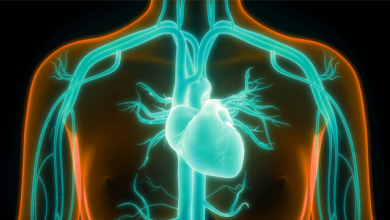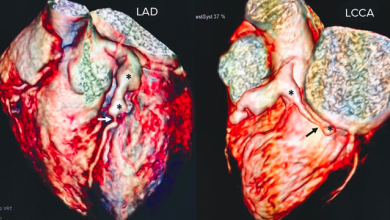Search results
Author(s):
Raffaele De Caterina
Added:
3 years ago
Atrial fibrillation (AF) is the most common sustained cardiac arrhythmia1 and increases the risk of stroke and thromboembolism, on average, fivefold.2 Strokes in AF are generally more severe and associated with greater mortality and disability than strokes from other causes.3 Prevention of stroke and thromboembolism is therefore an important part of AF management. Guidelines have, until now,…
View more
Author(s):
Bernhard Meier
Added:
3 years ago
The patent foramen ovale (PFO) is a common remnant of the intrauterine phase. After birth, the pressure in the right atrium drops with the first breath. The flap–valve-like gap between the cranial muscular septum secundum and the caudal membranous septum primum closes like a door ajar in a draught. Normally, the two septa have sufficient overlap and the septum primum is quite stable, allowing…
View more
Author(s):
Renata Cífková
Added:
3 years ago
Hypertension is the most prevalent cardiovascular disease affecting 20–50 % of the adult population.1 Elevated blood pressure has been identified as a risk factor for coronary heart disease (CHD), heart failure, stroke, peripheral arterial disease, renal failure and atrial fibrillation both in men and women in a large number of epidemiological studies.2–4 So far, the largest meta-analysis of…
View more
Author(s):
Gheorghe-Andrei Dan
,
Adrian Catalin Buzea
Added:
3 years ago
Non-antivitamin K oral anticoagulants (NOACs) are no longer ‘new’ drugs: they already are established. Since randomised controlled trials (RCTs) usually enrol highly selected patient populations, the best way to demonstrate new drug efficiency/cost-effectiveness is to use long-term and ‘real-world’ data. In order to understand the NOAC experience in real life properly, one must first understand…
View more
Author(s):
Pierluigi Merella
,
Giuseppe Talanas
,
Giovanni Lorenzoni
,
et al
Added:
6 months ago
Author(s):
Leslie Marisol Lugo
,
Rafael Romaguera
,
Joan Antoni Gómez-Hospital
,
et al
Added:
3 years ago
Transcatheter aortic valve implantation (TAVI) is the therapy of choice for patients with symptomatic severe aortic stenosis who are unsuitable for surgical aortic valve replacement and for elderly patients with high operative risk.1,2 It is also considered to be a more than valid and reasonable alternative to surgical aortic valve replacement for patients with moderate to high surgical risk.3,4…
View more
Author(s):
Irene Martín de Miguel
,
Pablo Ávila
Added:
3 years ago
Author(s):
Miguel Mendes
Added:
3 years ago
As far as I know, the designation ‘optimal medical treatment’ was first used by the Clinical Outcomes Utilizing Revascularization and Aggressive Drug Evaluation (COURAGE) trial1 investigators as a synonym for the state-of-the-art measures encompassing drug regime, diet and physical activity recommended by the US guidelines for stable angina and acute coronary syndrome (ACS). Looking at the most…
View more
Author(s):
Tamara García Camarero
,
José M de la Torre Hernández
Added:
3 years ago
The use of dual antiplatelet therapy (DAPT) after stent implantation in a percutaneous coronary intervention (PCI) is the standard treatment. The first randomised controlled trial (RCT) to establish the superiority of DAPT versus oral anticoagulant treatment among patients undergoing PCI was the Intracoronary Stenting and Antithrombotic Regimen (ISAR) trial, published in 1996.1 Since then, more…
View more
Author(s):
Alessandro Cavalcanti Lianza
,
Maria de Fátima Rodrigues Diniz
,
Karen Saori Shiraishi Sawamura
,
et al
Added:
8 months ago














